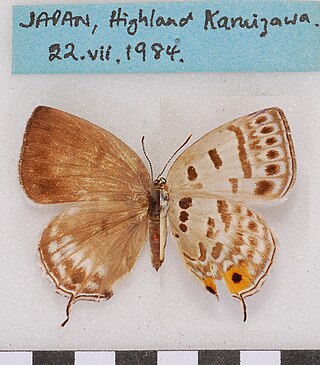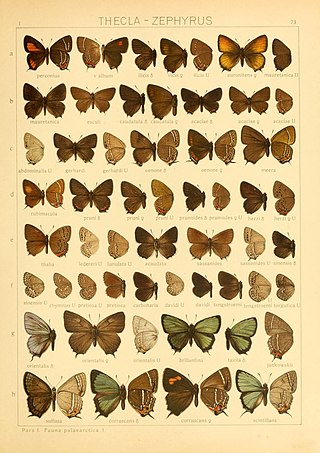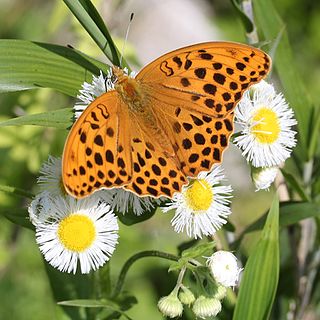
The silver-washed fritillary is a common and variable butterfly found over much of the Palearctic realm – Algeria, Europe and across the Palearctic to Japan.

The brown hairstreak is a butterfly in the family Lycaenidae. The range includes most of the Palaearctic.

The dark green fritillary is a species of butterfly in the family Nymphalidae. The insect has a wide range in the Palearctic realm - Europe, Morocco, Iran, Siberia, Central Asia, China, Korea, and Japan.

Melitaea diamina, the false heath fritillary, is a butterfly of the family Nymphalidae.

The scarce large blue is a species of butterfly in the family Lycaenidae. It is found in Austria, Slovenia, Croatia, the Czech Republic, France, Georgia, Germany, Hungary, Italy, Japan, Kazakhstan, Mongolia, Poland, Romania, Russia, northern Serbia, Spain, Switzerland, and Ukraine and East across the Palearctic to Japan. The species was first described by Johann Andreas Benignus Bergsträsser in 1779.

Scolitantides orion, the chequered blue, is a species of butterfly in the family Lycaenidae. It is found in Europe, Russia and east across the Palearctic to Japan.

Lopinga deidamia is a species of butterfly in the family Nymphalidae. It is found from the Urals to southern Siberia, China, Mongolia, Korea and Japan.

Artopoetes pryeri is a small butterfly found in the East Palearctic that belongs to the lycaenids or blues family.

Antigius butleri is a small butterfly found in the East Palearctic that belongs to the lycaenids or blues family.

Celastrina oreas is a small butterfly found in the East Palearctic that belongs to the lycaenids or blues family.

Chrysozephyrus brillantinus is a small butterfly found in the East Palearctic that belongs to the lycaenids or blues family.

Carterocephalus dieckmanni is a species of butterfly found in the East Palearctic that belongs to the skippers family.

Argynnis anadyomene is a butterfly found in the East Palearctic that belongs to the browns family.

Dilipa fenestra is a butterfly found in the East Palearctic that belongs to the browns family.

Satyrium eximius is a butterfly found in the East Palearctic that belongs to the blues family.

Limenitis helmanni is a butterfly found in the East Palearctic that belongs to the browns family.

Limenitis homeyeri is a butterfly found in the East Palearctic that belongs to the browns family.

Athyma recurva is a butterfly found in the Palearctic that belongs to the browns family. It is endemic to China.

Athyma punctata is a butterfly found in the Palearctic that belongs to the browns family. It is endemic to China.

















